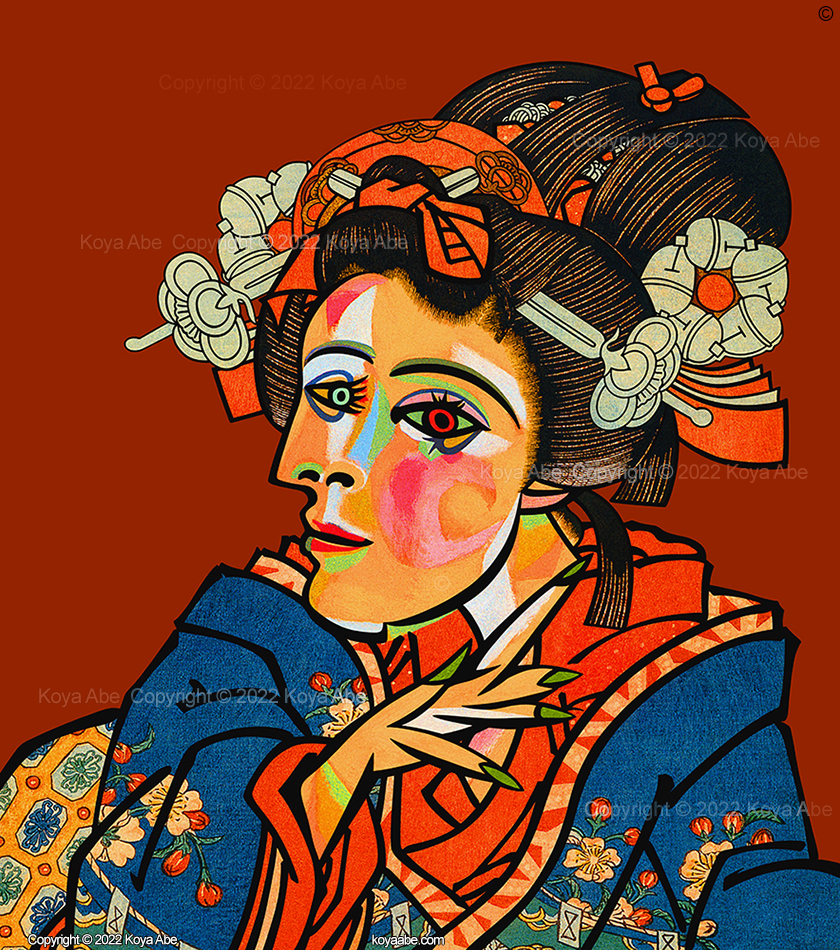I did not intend to make Pop Art at all. Though I did have a little Tomato Soup for lunch, I never did paint its image. Nor did I paint anything on a urinal. I realized that I did not go to the beach this year either and that was because the Wave was just too high. Indeed, it all may have been a big mistake.
Pablo Picasso was born in late 19th century Europe and it shouldn’t be surprising that he came to possess a large number of ukiyo-e prints within his personal collection, particularly the erotic variety known as shunga. The collection suggests that Picasso was interested in Japanese art, which was already known to and had influenced European artists.
The influence of shunga on Picasso is not widely recognized, but when considering the evidence, it can be found throughout Picasso’s work. For example, Picasso’s “Reclining Nude” of 1932” pays tribute to Hokusai’s “The Dream of the Fisherman’s Wife.” This 1932 work reveals Picasso’s attentiveness to shunga and is perhaps the most obvious example. His later work, the “Raphael et la Fornarina” series, undoubtedly further displays Picasso’s direct response to shunga.
The artistic proposition of Picasso’s portraits induces viewers to search for the sitter’s characteristics. In the painting, Picasso’s artistic suggestion presents an appearance of the subject that departs from the sitter’s actual appearance. It could be argued that the reality presented in these paintings is superior to what a photograph could achieve. As an artistic method, Picasso knew that realism had limitations and that its constraints would hinder the achievement of his goals. Realism imparts a superior visual accuracy, but for Picasso’s purposes, it cannot convey the essence of his subject matter. Ironically, an accurate visual representation can often limit the viewer’s artistic perception of the subject.
Yakusha-e is another style of traditional Japanese ukiyoe-e print which consists of portraits of kabuki actors. Through its particular form of representation, the intent of Yakusha-e is to represent the character of the subject, but without using realism. In this way, the yakusha-e method elevates the depiction of the subject to a different level of veracity. It is evident that Picasso was using a non-realism approach to portraiture that is consistent with the concept that underlies yakusha-e. Two works, Picasso’s The Weeping Woman (1937) and Toshusai Sharaku’s Otani Oniji III (1794) each respectively confirmed this observation for me. These artworks show that supreme “realism” doesn’t necessarily rest on photographic accuracy, but can be founded upon visual abstraction.
Both Picasso and Sharaku knew that dynamism is beyond the capacity of classic realism. They understood that ultimately art is founded upon the human perspective, not on scientific or technical accuracy. (And, as we know, Modern and Contemporary art have proven these points already). Reality is independent from a scientific framework and a technically accurate visual representation is just one option for an artist.
For me, the fact that realism is unable to capture the essence of the reality you see in the world is an amusing paradox. This paradox shows me that true reality exists only in the brain. Perhaps both Sharaku and Picasso have tried to create their own personal theater inside of Your Brain, but in their own respective “grooves.” Conceivably, I could call that theater in your brain Kabuki theater. There, Picasso is certainly groovy, Sharaku is groovy, and of course, Kabuki itself is groovy.
After all this, I feel Hokusai smiling down from somewhere and Andy Warhol whispers “it’s Pop.” And I can hear Duchamp shouting, “They have a hot ass,” or perhaps he is saying, “Reality is a true absence.” Kabuki is where it happens.
Koya Abe
New York, 2022
Topology of Art Chapter 11, Kabuki, is intended to be the final project in my trilogy that examines Japanese art and aesthetics consisting of the ukiyo-e art form and traditional tattoos/irezumi. These subject matters correspond to my earlier projects, Digital Art Chapter 1, Chapter 5, and this project, Chapter 11, accordingly. The trilogy forms a non-linear section with the larger Topology of Art series, which explores the history of art, culture, and technology.
